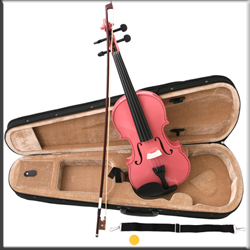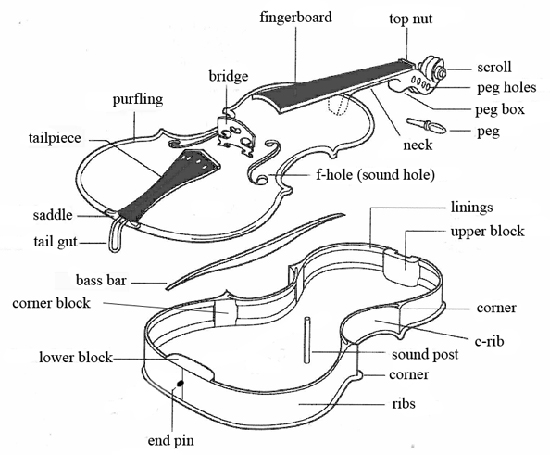The Real Costs of a Cheap Violin
 Right now on eBay and some other online retailers, you can find “great” deals on violin and viola outfits for under $100, and cello outfits for under $200! What do these instruments really cost, though, if you want to make them playable?
Right now on eBay and some other online retailers, you can find “great” deals on violin and viola outfits for under $100, and cello outfits for under $200! What do these instruments really cost, though, if you want to make them playable?
Upon arrival the instrument comes with everything you need to get started–but hold on a minute! I cannot tell you how many people come into our shop because they have attempted to tune the instrument and cannot get it to work, even if they do manage to get the bridge up. So let’s discuss point by point what your new low priced outfit needs to actually get rolling.
The Bow: This is often seen as an accessory to the violin, but I’ll talk about this first because the bow is so much more. Without the bow a violin, viola, or cello is just an oddly shaped/tuned ukulele. Not to belittle the potential of a plucked instrument, but what really makes a violin a violin is the bowing. 99% of the time, the bows that come with these outfits are nearly unusable. Floppy, warped, weak wood painted orange to look like the Brazilwood they claim it to be is almost always the condition of the bow right out of the box. It is haired with the worst quality horse hair and haired improperly to boot. I always suggest the bow be replaced. Decent, usable student bows start at $40 (2/3 of the price of the whole outfit). I usually commend a $100 carbon fiber bow.
The Case: The cases that come with these outfits are Styrofoam with cloth glued on it, with no hardware other than cheap zippers, and are very poorly constructed. These cases only rarely last even a year unless they are not used at all. Decent quality student level cases that will withstand a couple years of regular use start at $95–more than the entire “bargain” outfit!
The Violin: Where to begin? The instruments themselves are usually plywood with the inlay around the edges painted on (which of course means it is not inlay). Sometimes they are solid carved wood, but of the lowest quality–you’re actually better off with the plywood at these prices.
The finish (or paint) is, well…ugly at best and will fail and begin falling off the instrument at worst.
The fingerboard is some mystery wood painted black (ebonized). The fingerboards are often warped (or will warp over time), or are made improperly and can cause buzzing sounds.
The nut is made of the same material as the fingerboard and is never cut correctly, meaning the strings are almost always too high–making it hard to press them down.
to press them down.
The pegs are also some mystery wood painted black, and you’ll be lucky if your luthier will be able to get them to work very well. This makes tuning the instrument very difficult. They are also susceptible to breakage.
The bridge is always the flimsiest maple available, the feet are never fit right, and the curvature is always too flat making it very hard to bow just one string at a time. If the bridge is even usable, it will not last more than a few months, at best, before it begins to warp and the strings have cut into the notches so deeply as to render the instrument unplayable.
The tailpiece is very poorly made and the fine tuners often are hard to turn and will strip out and become unusable in a short time.
The tail gut holding the tailpiece on is suspect–often these instruments come in after only a few weeks of use and the gut has broken.
The end pin, similar to the pegs, is often misfit and may pop out.
The soundpost is also never fit right, and is jammed in so tightly that it can be quite a project to get it out and fit it correctly. The soundpost is not only structural, it is integral to how the instrument sounds and responds and being wedged in that tightly is far from ideal.
Finally, the strings–the ones that come on these instruments are completely horrendous! Thin, stiff, and sharp, they will dig into a player’s fingers. They also produce a terrible, grating metallic sound, not at all the sound you dreamed of before deciding to learn the violin. Useable student level strings start at around $20+ for a set; better strings are closer to $40.
What I have described above is really only the beginning of the headaches that come equipped with your new, cheap, instrument. Over time the poor construction will truly reveal itself as pegs completely stop functioning, the fingerboard warps, seams open up and separate, finish flakes off, and the neck cracks or comes unglued from the body of the instrument. Ribs shrink and crack, the laminate top caves in—it isn’t pretty. Not all of these fates befall every “bargain” instrument, but one or more invariably does, rendering the instrument unplayable.
That “bargain” violin that you can buy for under $100 doesn’t sound like such a bargain anymore. The cost of setting it up properly or repairing it almost immediately can easily add $200 to the price. The additional costs for viola are similar, but for cello, often times the instruments are even more poorly made and the costs associated with making them usable can be much, much higher. Of course, there are additional costs besides monetary ones–for information on the obstacles these instruments place in front of beginning musicians, see my article titled “Try it on a Cheap Violin First?”
One might be tempted to think that my descriptions here are extreme and misleading because I want you to purchase or rent a quality instrument from Seery Strings. Sadly, this article probably understates the absence of quality in these instruments, and I truly want people to have a good experience with music whether they are our customers or not. I also don’t want to mislead anyone into thinking that if you spend a little more than this that you’ll get something much better. Properly constructed instruments made with quality materials, come with quality components, and that are capable of producing a good tone cost many times more than these cheap prices. The set up is such a crucial factor that buying locally from a orchestral strings specialist is really the way to go. If affordability is an issue — try renting.
Date
March 14, 2018
Category
Learn


